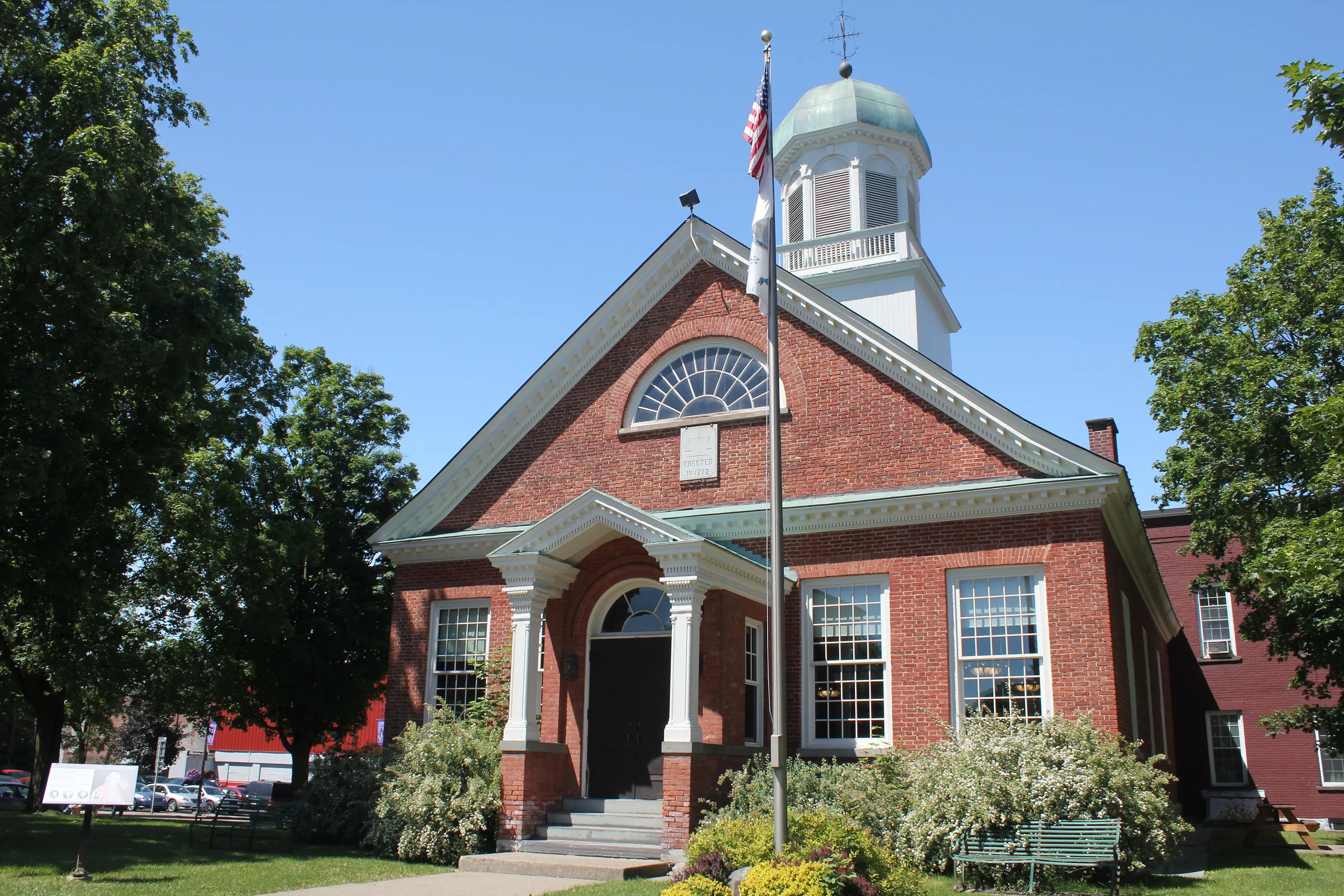
Fulton County Courthouse
Fulton County was originally in Albany County
On May 9th of 1769, a bill was introduced in the Provincial Assembly to create a new county out of "the westernmost part" of Albany County.
At that time, Albany County comprised all of the Colonial Province of New York from Ulster and Dutchess Counties to Fort Stanwix (now Rome) and the Iroquois land to the west.
In a letter dated November 28, 1771, Guy Johnson suggested to his uncle (and father-in-law), Sir William Johnson, that the courthouse for the new county be located in Johnstown. Sir William concurred with this recommendation and offered to contribute "to the erection of the necessary Edifies."
On March 12, 1772, the Provincial Assembly created Tryon County out of the western half of Albany County and designated Johnstown as the county seat where the King's Court was to be held . Construction of the Courthouse commenced immediately under Sir William's personal direction. On May 21, 1772, he wrote: "I am now carrying on a handsome building for a Court House, toward which I shall contribute t 500 ." (The good baronet also supplied 25 gallons of rum during the summer of 1 772 to refresh the brick masons, millwrights and other sundry help during the hot months which must be the first recorded instance of fringe benefits in the new county's history.)
First Court of General Sessions
The courthouse was only partially finished when, on September 8, 1772, the first Court of General Sessions to he held West of Albany was convened. Present as judges were Guy Johnson, who was to succeed Sir William as Superintendent of Indian Affairs for the Northern Zone; John Butler, who was with General Braddock at Fort Duquesne and later commanded the notorious Butler's Rangers during the Revolution; and Peter Conyne, who served with distinction with the Tryon County Militia during the Revolution. Serving as Assistant Judges for the first court session were Sir John Johnson, son of Sir William Johnson, Daniel Claus, John Wells and Jelles Fonda. The first Sheriff of Tryon County, Alexander White, was also present. A grand jury was sworn, and the legal history of the courthouse began with a load of six cases.
On February 6, 1773, the Colonial Legislature directed that the sum of 1,600 pounds be levied on the freeholders and inhabitants of Tryon County - plus the cost of collection figured to be three pence per pound - for the completion of the courthouse and the erection of a jail. (Obviously, the legislature had some idea about the strict application of the law or was concerned about the unruly nature of the local populace.)
The Colonial legislature stated on April 1, 1775 that "the money raised to complete the Court House and Gaol at John's Town in the County of Tryon has been found insufficient," and directed the levying of yet an additional 900 pounds toward the completion of the structure as well as naming Sir John Johnson as trustee to replace his recently deceased father.
But not everything connected with the courthouse was so heavy handed. For instance, on December 13, 1775, court was adjourned to Gilbert Tice's Tavern where it sat until five a.m. when a further adjournment was taken until ten o'clock the following morning. (One assumes that the session was concluded more formally - if, perhaps, less congenially - at that time.)
Sir John Johnson made his last appearance at the courthouse in the town named for him on March 12, 1776 when he served as one of the three presiding judges. By that time, of course, the Mohawk Valley was already boiling with revolutionary sentiment which led Sir John to decamp - along with 170 tenants and friends - for St.Regis in Canada on May 1, 1776.
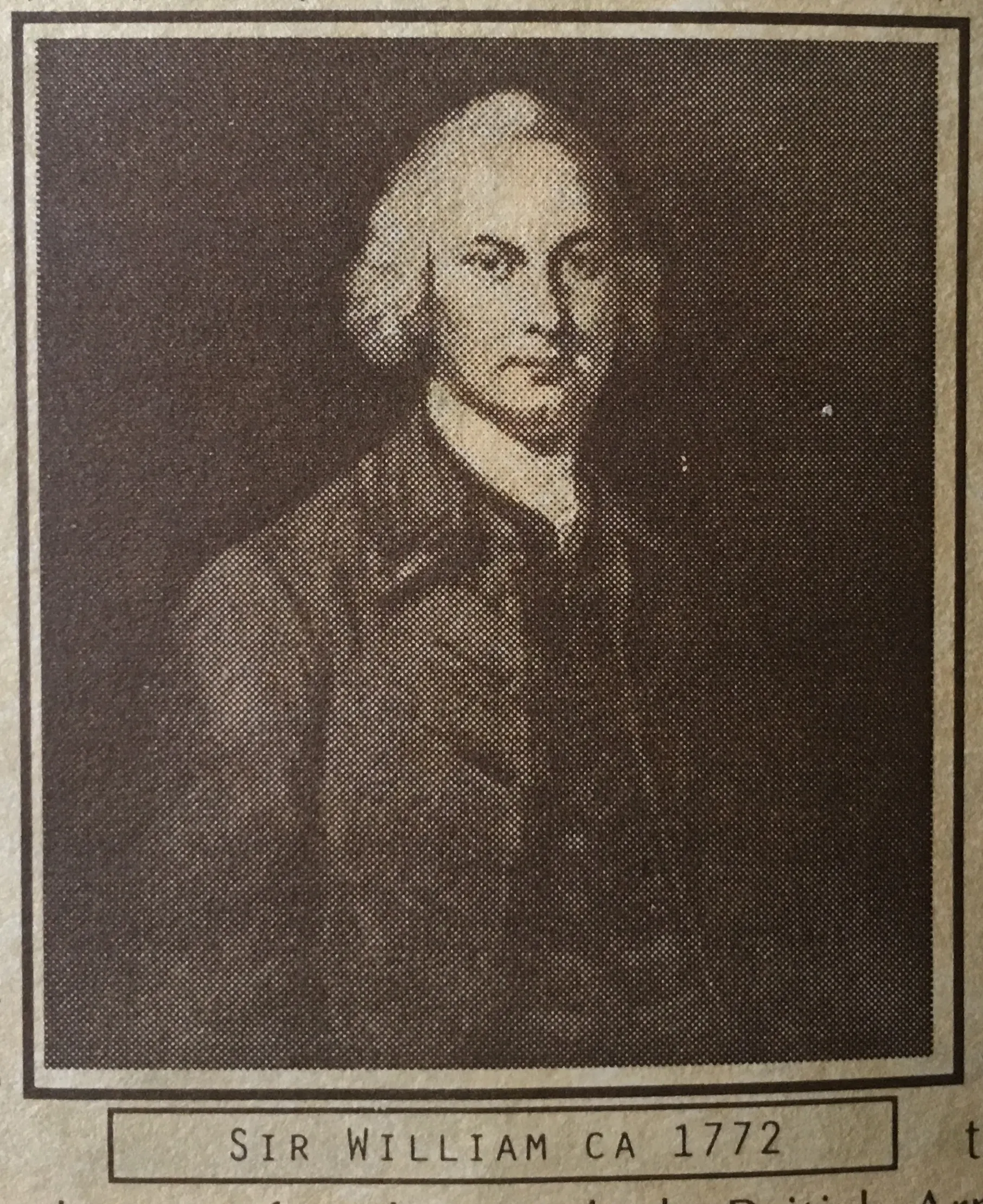
Sir William Johnnson
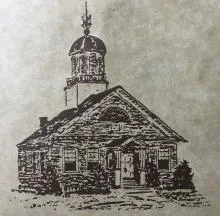
Courthouse Etching
Revolutionary War
The session held on October 9, 1781 in the Courthouse was one fraught with danger for the participants, but, happily, they were then unaware of the approaching onslaught. A powerful loyalist raiding party was on its way down the Mohawk Valley headed for Johnstown, commanded by Major Ross, second in command by Captain Walter Butler. Captain Butler had appeared as a lawyer in the old courthouse prior to the conflict and his father,John Butler, had served as one of the three judges at the first session held in the courthouse and had formed and commanded as its colonel, the Loyalist unit known as Butler's Rangers. Many of the persons in the Court that October day would be under fire at the Battle of Johnstown just 17 days later.
The Battle of Johnstown was fought October 25, 1781, and is considered one of the battles of the Revolution fought in New York State. The Loyalist forces were driven back to Canada and a couple days later at a fording on the West Canada Creek, Captain Walter Butler was killed. News reached Johnstown about the same time of the death of the notorious Walter Butler and the defeat of Cornwallis and the British Army at Yorktown. Bond fires were lit in the street and the courthouse bell was rung and it is said the residents rejoices more over the death of Butler than the defeat of the whole British Army.
Tryon County Renamed
On April 2, 1784, the county lost its Loyalist designation of "Tryon" and was officially renamed Montgomery County after a Revolutionary War hero, General Richard Montgomery, who was killed during the storming of Quebec, in 1775. And, of course, the courthouse became the Montgomery County Courthouse.
In 1792, the Supervisors of the county ordered two large and two small stoves to be purchased for the courthouse, that the lots be completely fenced and that a row of elms or willows be planted in front of the building. Clearly, comfort and beautification must have been the consideration of the elected leaders of the community, stealing a very early lead on some later national public figures.
On October 26, 1807, town meetings in the courthouse were prohibited, and, on October 30, 1810, the supervisors forbade the future holding of school in the building. Obviously, the courthouse did a lot more than serve justice in the early years of the county.
Use and Improvements of the County Courthouse
A year after the Southwick - Sheldon case, four slaves were publicly sold in front of the courthouse, bringing but $450.00 for their lives.
In November of 1836, the Sheriff of the county was directed to refuse further use of the property for any meeting to discuss or lecture on slavery "believing that such discussions are calculated to disturb the public peace."
Thankfully, that did not end discussions of the matter in the county; however, it properly took such discussions from the seat of impartial justice.
On October 6, 1826, the Sheriff was directed to purchase and install a bell in the courthouse (price: $30). The bell was not replaced. The original bell placed there in 1772 is still housed in the belfry of this old structure. It consists of a piece of wrought iron bent into the shape of a triangle, suspended in the belfry. A hammer on a hinge strikes the triangle when a rope is pulled; the bell gives off a dull clang. This old bell was rung at the surrender of Cornwallis at Yorktown, during the news of the signing of the Declaration of Independence and our U.S. Constitution, the same as the Liberty Bell in Philadelphia and in recent years when all the bell is across the nation were rung in the 200th celebration of the U.S. Constitution.
Changing of the County Seat
It was apparent that there was considerable sentiment for the removal of the county seat from Johnstown to a more southern location as far back as 1816. On October 2 of that year, the Board did "earnestly remonstrate against any dismemberment of this County, and also against any project for building an additional court house and gaol for said County."
The opening of the Erie Canal in 1825 and the Utica and Schenectady Railroad in 1836 redirected traffic from the old state road through Johnstown, leaving the county seat well off the beaten path; an influential group of citizens in the southern part of Montgomery County ~ succeeded in getting the county seat moved to Fonda in May of 1836. On March 14, 1837, "the building situated in the Village of Johnstown, heretofore known as the Court House, Jail, and Clerk Office of the county of Montgomery" were sold at public auction to the highest bidder. The buildings sold for the magnificent sum of $2,040 as recorded on December 6, 1837.
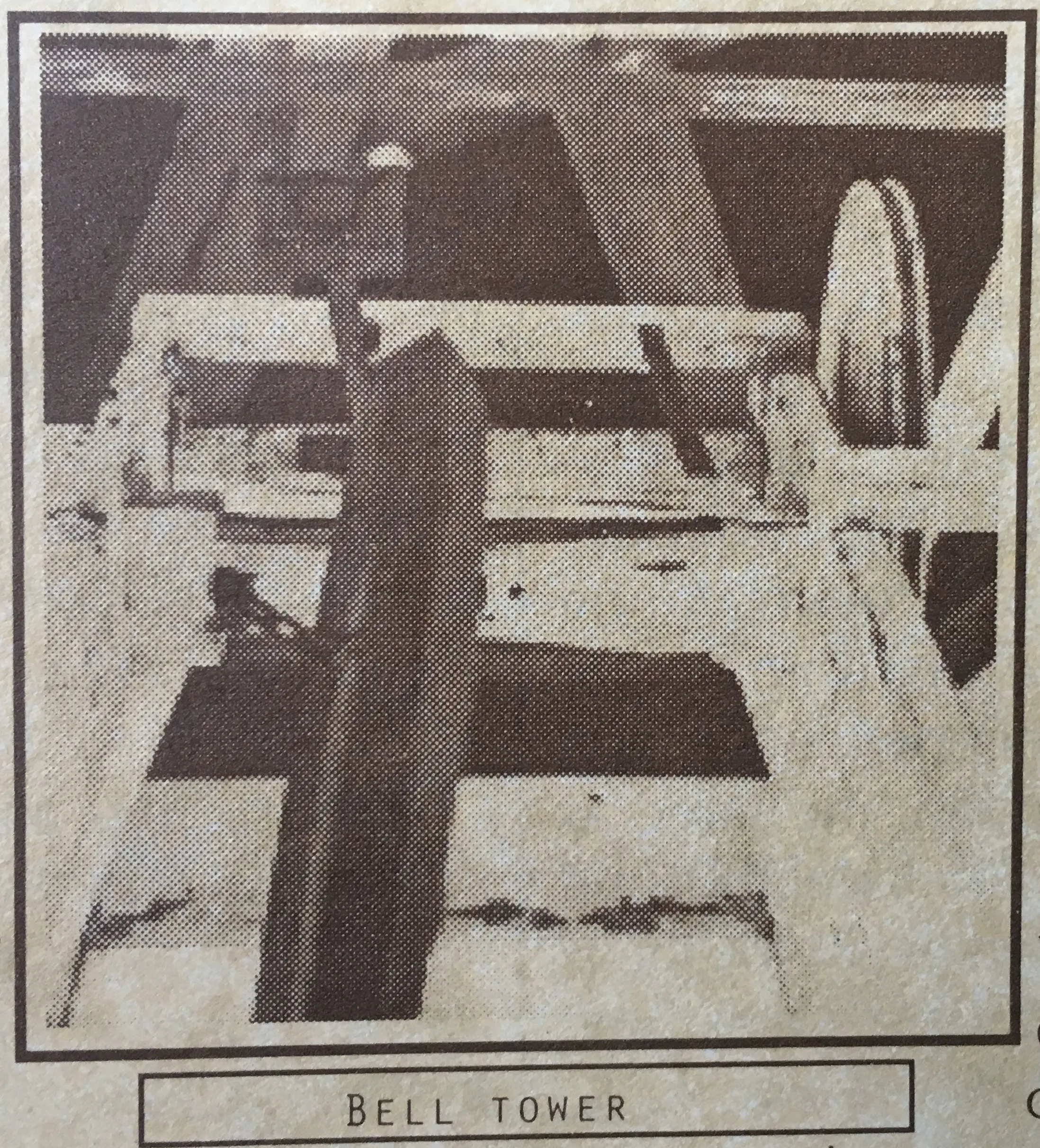
Courthouse Bell Tower
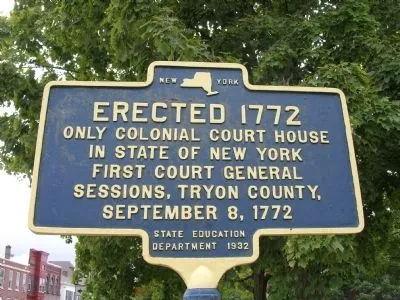
Courthouse Historical Marker
Fulton County is Created
However, the dissatisfaction of the people living in the northern part of old Montgomery County was such that a new county, named Fulton after the Robert Fulton who improved the invention of the steam engine, was formed by the State Legislature on April 18, 1838.
The new county was authorized to hold the Court of Common Pleas and General Sessions of the Peace in the "old Court House in the Village of Johnstown, and the re-purchase of the old Court House, Jail, and Clerk's Office in the village of Johnstown, formerly used as the Court House, Jail, and Clerk's Office of the County of Montgomery."
So, with the sole exception of thirteen months, the courthouse has been in continual use as the seat of justice in the area for over Two hundred and twenty five years, (as of 1997).
In 1851, the County Judge's salary was fixed at the munificent sum of $600, and 12 cushioned chairs were purchased for the comfort of the Petit jurors. But the courthouse was still heated by those wood stoves purchased back in 1792; it was not until 1857 that the structure was equipped with gas lighting (even then, it could not have been too well lit as the number of jets was carefully specified " not to exceed nine burners") .
And it would definitely appear that the sanitary facilities were still somewhat primitive as, on November 30, 1861, the Supervisors resolved "that the County Clerk be authorized to be put into proper repair the Privy on the Court House lot, the expense not to exceed ten dollars."
Since then, cosmetic and sanitary improvements have dramatically been made, but the Fulton County Court House - built as the Tryon County Court House in 1772 and renamed the Montgomery County Court House after the Revolutionary War - still stands and is used for the daily exercise of justice . The only Colonial Courthouse still in use in the State of New York and - perhaps - the only one still so utilized in the entire country.
A Famous Trial
In the spring of 1812, one of the most famous trials ever to be held in the courthouse was held. Alexander Sheldon, a former Speaker of the State Assembly, had charged that one Solomon Southwick of the Town of Charleston had attempted to bribe him to vote in favor of incorporating the Bank of America in New York City.
Southwick retained Aaron Burr as well as three other lawyers to defend him. By that time, Burr was one of the best known men in America, having served as an officer in the Army during the Revolutionary War, as a senator and as senator and as the Vice-President of the country. Additionally, he had killed Alexander Hamilton in a duel in 1804 and been tried (and acquitted) of the charge of treason in 1807.
There was a great public interest, and a large crowd attended the trial. One spectator, described Burr when he entered the Court Room as a small man with a large head, neatly dressed, with his powdered hair in a queue, and followed by a black servant carrying an armful of books. Despite Burr's unsavory reputation and a somewhat theatrical efforts of the prosecution, Southwick was aquitted of the charge.
Seperate County Clerk Building
The first recorded mention of a separate building to house the County Clerk occurred in a resolution of the Board of Supervisors adopted on October 22, 1813, appointing a committee to apply to the legislature for authority to erect a fireproof county clerk's building at the Southeast corner of the courthouse at a price not to exceed $600. (Building costs. you may note, have risen somewhat since those days.) In the Fall of 1814, the Supervisors authorized the purchase of furniture and a stove for this new structure. And, in 1817 the Board authorized the purchase of a "dye and impression to stamp the seal of the county and court upon the process and proceedings thereof."
Historian Links

